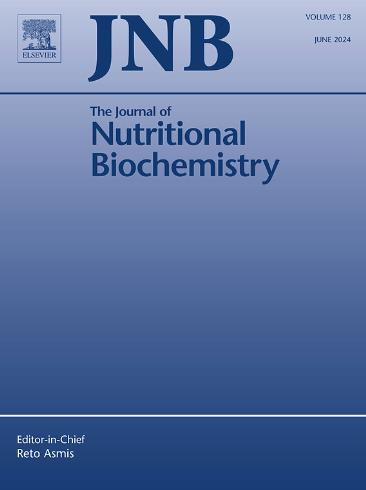Integrated multiomics analysis reveals the effect of glucose selenol improves rat immunity
IF 4.9
2区 医学
Q1 BIOCHEMISTRY & MOLECULAR BIOLOGY
引用次数: 0
Abstract
This study aimed to investigate the effects of glucose selenol (SeGlu) on the immune function of rats, with a particular focus on the spleen. Rats were randomly divided into CK (deionized water, oral), Se0.15 group (0.15 mg/L SeGlu, oral), and Se0.4 group (0.4 mg/L SeGlu, oral) for 30 days continuously. 0.15 mg/L SeGlu significantly increased the serum antioxidant levels and the levels of IgM and IgG. The Se0.4 group upregulated the inflammatory factor levels of IL-2 and IL-6, and both concentrations significantly reduced the serum TNF-α level. Transcriptome analysis indicated that the supplementation of SeGlu could affect three types of proteins: peptidases, tumor necrosis factor receptors, and transmembrane transport proteins. KEGG enrichment discovered pathway annotations directly or indirectly related to the immune process, especially phagosomes, natural killer cell-mediated cytotoxicity, and nod-like receptor signaling pathways. We identified 59 SeGlu target differentially expressed genes and 8 (NEG) and 20 (POS) co-expressed differentially expressed metabolites. Immunoglobulin-related DEGs were concentrated in the transcription factor family V-set, and were identified on chromosome 6. In addition, metagenome sequencing showed that SeGlu treatment increased abundance of Roseburia, Ruminococcus, Eubacterium, Coprobacillus, and Intestinimonas at the genus level. Spearman correlation analysis results showed that the modulatory effects of SeGlu on d-proline were related to the regulation of Roseburia, Clostridium, Eubacterium Coprobacillus, Butyricimonas, and Muribaculum. Overall, the analyses of rat physiology, transcriptome, metabolome, and metagenome offer new insights into Se on rat immunity. SeGlu provides beneficial immune protection and is a promising organic selenium enrichment additive.

综合多组学分析揭示了葡萄糖硒醇提高大鼠免疫力的作用。
本研究旨在探讨葡萄糖硒醇(SeGlu)对大鼠免疫功能的影响,特别是对脾脏的影响。将大鼠随机分为CK(去离子水,口服)、Se0.15组(SeGlu 0.15 mg/L,口服)和Se0.4组(SeGlu 0.4 mg/L,口服),连续30 d。0.15 mg/L SeGlu显著提高血清抗氧化水平和IgM、IgG水平。Se0.4组上调炎性因子IL-2和IL-6水平,且两者浓度均显著降低血清TNF-α水平。转录组分析表明,添加SeGlu可以影响三种类型的蛋白质:肽酶、肿瘤坏死因子受体和跨膜转运蛋白。KEGG富集发现了与免疫过程直接或间接相关的通路注释,特别是吞噬体、自然杀伤细胞介导的细胞毒性和节点样受体信号通路。我们鉴定出59个SeGlu目标差异表达基因和8个(NEG)和20个(POS)共同表达差异表达代谢产物。免疫球蛋白相关的deg集中在转录因子家族v集,并在6号染色体上鉴定。此外,宏基因组测序显示,SeGlu处理在属水平上增加了Roseburia, Ruminococcus, Eubacterium, Coprobacillus和n肠菌的丰度。Spearman相关分析结果显示,SeGlu对d -脯氨酸的调节作用与Roseburia、Clostridium、Coprobacillus、Butyricimonas和Muribaculum的调节作用有关。总的来说,对大鼠生理、转录组、代谢组和宏基因组的分析为硒对大鼠免疫的影响提供了新的见解。SeGlu提供有益的免疫保护,是一种很有前途的有机富硒添加剂。
本文章由计算机程序翻译,如有差异,请以英文原文为准。
求助全文
约1分钟内获得全文
求助全文
来源期刊

Journal of Nutritional Biochemistry
医学-生化与分子生物学
CiteScore
9.50
自引率
3.60%
发文量
237
审稿时长
68 days
期刊介绍:
Devoted to advancements in nutritional sciences, The Journal of Nutritional Biochemistry presents experimental nutrition research as it relates to: biochemistry, molecular biology, toxicology, or physiology.
Rigorous reviews by an international editorial board of distinguished scientists ensure publication of the most current and key research being conducted in nutrition at the cellular, animal and human level. In addition to its monthly features of critical reviews and research articles, The Journal of Nutritional Biochemistry also periodically publishes emerging issues, experimental methods, and other types of articles.
 求助内容:
求助内容: 应助结果提醒方式:
应助结果提醒方式:


